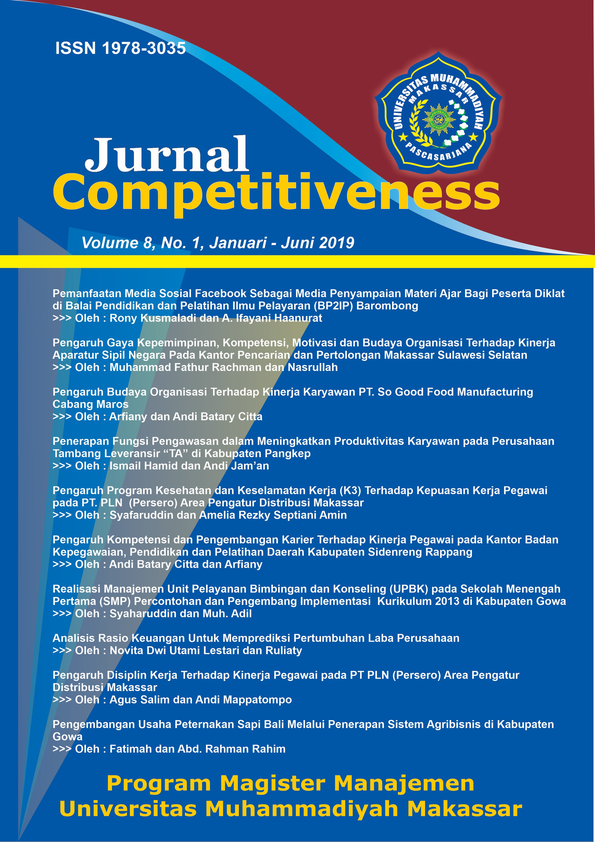ANALISIS RASIO KEUANGAN UNTUK MEMPREDIKSI PERTUMBUHAN LABA PERUSAHAAN
DOI:
https://doi.org/10.26618/jmbc.v8i1.4475Abstract
This research was conducted to test the influence of Variable Working Capital to Total Asset (WCTA), Current Liabilities To Inventory (CLI), Operating Income to Total Assets (OITL), Total Asset Turnover (TAT), Net Profit Margin (NPM) and Gross Profit Margin (GPM) on profit growth. The data was obtained by purposive sampling method with the criteria of Multi-Industry Manufacturing Companies in the automotive sector and components listed on the Indonesia Stock Exchange (IDX) in 2012-2016.
The results of the analysis showed that the data used in this study have fulfilled classical assumptions, which include: no symptoms of multicolinearity, no autocorrelation, no symptoms of heterosceticity, and normal distributed data. From the results of regression analysis shows that variable Working Capital to Total Asset (WCTA), Current Liabilities To Inventory (CLI), Net Profit Margin (NPM) and Gross Profit Margin (GPM) have a significant positive effect on profit growth. While the variables Operating Income to Total Assets (OITL) and Total Asset Turnover (TAT), have no significant effect on profit growth. The six variables used in this study (WCTA, CLI, OITL, TAT, NPM and GPM) jointly influenced profit growth.
Keywords: Working Capital to Total Asset (WCTA), Current Liabilities To Inventory (CLI), Operating Income to Total Assets (OITL), Total Asset Turnover (TAT), Net Profit Margin (NPM), Gross Profit Margin (GPM) and profit growth.
References
Ang, Robert, 1997, Buku Pintar: Pasar Modal Indonesia, Mediasoft Indonesia
Aryanto Risnawati Ulfinabella, Titisari Hendra Kartika, dan Nurlaela Siti, 2018, “Pengaruh Likuiditas, Leverage, Profitabilitas, dan Aktivitas Terhadap Pertumbuhan Laba”. Seminar Nasional IENACO ISSN 2337- 4349.
Asyik, Nur Fadjrih dan Soelistyo, 2000,”Kemampuan Rasio Keuangan dalam Memprediksi Laba”, Jurnal Ekonomi dan Bisnis Indonesia, Vol.15, No. 3
Belkaoui, Ahmed, dkk, 1993, Teori Akuntansi, Edisi Kedua, Erlangga
Dennis, Michael, 2006, “Key Financial Rastios for The Credit Department”, Business Credit, New York, Nov./Dec., Vol.108, Iss. 10; pg. 62, 1 pgs
Hapsari, Epri Ayu dan Prasetiono, 2007, “Analisis Rasio Keuangan Untuk Memprediksi Pertumbuhan Laba (Studi Kasus: Perusahaan Manufaktur Yang Terdaftar di Bursa Efek Jakarta Periode 2001 sampai dengan 2005),Jurnal Studi Manajemen dan Organisasi, Vol.6.No.1.
Khaldun Ibnu Khalidazia dan Muda Iskandar, 2014, “The Influence Of Profitability and Liquidity Ratios On The Growth Of Profit Of Manufacturing Companies”, Vol. 2 Issue 12
Martono, Harjito Agus, 2004. Manajemen Keuangan, Edisi Kedua, Cetakan Kedelapan, Penerbit Ekonosia, Yogyakarta
Mulyana Ayu, Zuraida, dan Saputra Mulia, 2018, “The Influence of liquidity, Profitability and Leverage on Profit Management and its Impact onCompany Value in Manufacturing Company listed on indonesia Stock Exchange”, Vol. 6 Issue 1
Reksoprayitno, Soediyono, 1991, Analisis Laporan Keuangan: Analisis Rasio, Liberty, Yogyakarta
Riyanto, Bambang, 1995, Dasar-dasar Pembelanjaan Perusahaan Edisi 4, BPFE,Yogyakarta
Salvatore, Dominick, 2001, Managerial Economics in a Global Economy 4thEdition, Harcourt College Publishers
Usman, Bahtiar, 2003, “Analisis Rasio Keuangan dalam Memprediksi Perubahan Laba pada Bank-Bank di Indonesia”, Media Riset Bisnis & Manajemen, Vol 3 No. 1
Usman, Bahtiar, 2003, “Analisis Rasio Keuangan dalam Memprediksi Perubahan Laba pada Bank-Bank di Indonesia”, Media Riset Bisnis & Manajemen, Vol 3 No. 1
Wijayati, dkk, 2005, “Kemampuan Informasi Keuangan Memprediksi Perubahan Laba”, Jurnal Bisnis dan Manajemen, Vol. 5, No. 1

